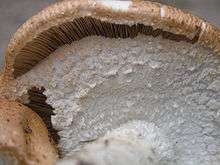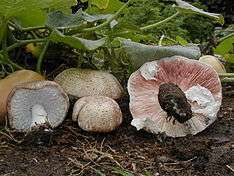Agaricus subrufescens
Agaricus subrufescens (syn. Agaricus blazei, Agaricus brasiliensis or Agaricus rufotegulis) is a species of mushroom, commonly known as almond mushroom, mushroom of the sun, God's mushroom, mushroom of life, royal sun agaricus, jisongrong, or himematsutake (Chinese: 杏仁松茸, Japanese: 姫まつたけ, "princess matsutake") and by a number of other names. Agaricus subrufescens is a choice edible, with a somewhat sweet taste and fragrance of almonds. The fungus is also well known as a medicinal mushroom, for its purported medicinal properties, due to research which indicates it may stimulate the immune system.
Taxonomy
Agaricus subrufescens was first described by the American botanist Charles Horton Peck in 1893.[1] During the late 19th and early 20th centuries, it was cultivated for the table in the eastern United States.[2] It was discovered again in Brazil during the 1970s, and misidentified as Agaricus blazei Murrill, a species originally described from Florida. It was soon marketed for its purported medicinal properties under various names, including ABM (for Agaricus blazei Murrill), cogumelo do sol (mushroom of the sun), cogumelo de Deus (mushroom of God), cogumelo de vida (mushroom of life), himematsutake, royal sun agaricus, Mandelpilz, and almond mushroom.
In 2002, Didukh and Wasser correctly rejected the name A. blazei for this species, but unfortunately called the Brazilian fungus A. brasiliensis,[3] a name that had already been used for a different species, Agaricus brasiliensis Fr. (1830). Richard Kerrigan undertook genetic and interfertility testing on several fungal strains,[2] and showed that samples of the Brazilian strains called A. blazei and A. brasiliensis were genetically similar to, and interfertile with, North American populations of Agaricus subrufescens. These tests also found European samples called A. rufotegulis to be of the same species. Because A. subrufescens is the oldest name, it has taxonomical priority.
Note that Agaricus blazei Murrill is a perfectly valid name, but for a completely different mushroom. Agaricus silvaticus is also a perfectly valid name for a common, north temperate, woodland mushroom. Neither is a synonym of Agaricus subrufescens.
Description

The cap is initially hemispherical, later becoming convex, with a diameter of 5 to 18 cm (2.0 to 7.1 in).[4] The cap surface is covered with silk-like fibers, although in maturity it develops small scales (squamulose). The color of the cap may range from white to grayish or dull reddish brown; the cap margin typically splits with age. The flesh of A. subrufescens is white, and has the taste of "green nuts", with the odor of almonds.[4] The gills are not attached to the stalk (free), narrow, and crowded closely together. They start out whitish in color, then later pinkish and finally black-brown as the spores mature. Spores are ellipsoid, smooth, dark purplish-brown when viewed microscopically, with dimensions of 6–7.5 by 4–5 µm. The stipe is 6 to 15 cm (2.4 to 5.9 in) by 1 to 1.5 cm (0.4 to 0.6 in) thick, and bulbous at the base. Initially solid, the stipe becomes hollow with age; it is cottony (floccose) to scaly towards the base.[4] The annulus is abundant and double-layered; it is bent downwards towards the stem, smooth and whitish on the upper side, and covered with cottony scales on the lower side.
Distribution and habitat
Agaricus subrufescens forms fruitbodies singly or in clusters in leaf litter in rich soil, often in domestic habitats.[5] Originally described from the northeastern United States and Canada, it has been found growing in California, Hawaii, Great Britain, the Netherlands, Taiwan, Philippines, Australia and Brazil.[2]
Edibility
Aroma
Agaricus subrufescens is a choice edible, with a somewhat sweet taste and fragrance of almonds. The almond smell of the mushroom is mostly due to the presence of benzaldehyde, benzyl alcohol, benzonitrile, and methyl benzoate.[6]
Commercial use
Because Agaricus subrufescens contains a high level of beta glucans, compounds known for stimulating the immune system,[7][8][9] the fungus is used in oncological therapy in Japan and Brazil.[10] In addition to beta glucans, the mushroom's effect on the immune system is believed to be due to other polysaccharides, such as alpha glucans.[11] In Japan, Agaricus subrufescens is sold under the brand names KingAgaricus 100, Sen-Sei-Ro Gold, and ABMK, and is used by an estimated 500,000 people[12] In Japan, Agaricus subrufescens is also the most popular complementary and alternative medicine used by cancer patients.[13] Although Agaricus subrufescens is cultivated in the United States, the largest exporters are China and Brazil. As noted in a scientific review of A. subrufescens research,[14] the range of quality in A. subrufescens cultivation can affect the mushroom's ability to impact cells of the immune system.
Recently, Tetsuo Watanabe published a report in the Biological and Pharmaceutical Bulletin on a novel hybrid of A. subrufescens called Basidiomycetes-X (BDM-X)[15] and a US patent[16] was issued on a novel hybrid of the A. subrufescens edible mushroom which was crossbred (hybridized) with another medicinal mushroom, resulting in a new hybrid claimed to possess 10 to 3000 times the potency of similar but unpatented mushrooms.
See also
References
- ↑ Peck CH (1893). "Report of the Botanist (1892)". Annual Report on the New York State Museum of Natural History. 46: 85–149.
- 1 2 3 Kerrigan, RW (2005). "Agaricus subrufescens, a cultivated edible and medicinal mushroom, and its synonyms". Mycologia. 97 (1): 12–24. doi:10.3852/mycologia.97.1.12. PMID 16389952.
- ↑ Wasser, Solomon P.; Didukh, Marina Ya.; de Amazonas, Maria Angela L.; Nevo, Eviatar; Stamets, Paul; da Eira, Augusto F. (2002). "Is a Widely Cultivated Culinary-Medicinal Royal Sun Agaricus (the Himematsutake Mushroom) Indeed Agaricus blazei Murrill?". International Journal of Medicinal Mushrooms. 4 (4): 267–290. doi:10.1615/intjmedmushr.v4.i4.10. OCLC 39977461.
- 1 2 3 Murrill, W. A. (1922). "Dark-Spored Agarics: III. Agaricus". Mycologia. 14 (4): 200–221. doi:10.2307/3753642. JSTOR 3753642.
- ↑ Smith, Alexander Hanchett (1975). A Field Guide to Western Mushrooms. Ann Arbor, Mich: University of Michigan Press. p. 228. ISBN 978-0-472-85599-5.
- ↑ Chen, CHU-CHIN; Wu, Chung-MAY (1984). "Volatile Components of Mushroom (Agaricus subrufecens)". Journal of Food Science. 49 (4): 1208–1209. doi:10.1111/j.1365-2621.1984.tb10433.x.
- ↑ Hetland, Geir; Sandven, P. (2002). "beta-1,3-Glucan reduces growth of Mycobacterium tuberculosis in macrophage cultures". FEMS Immunology and Medical Microbiology. 33 (1): 41–5. doi:10.1111/j.1574-695X.2002.tb00570.x. OCLC 27447797. PMID 11985967.
- ↑ Morikawa, Kaoru; Takeda, Reiko; Yamazaki, Masatoshi; Mizuno, Den'Ichi (1985). "Induction of Tumoricidal Activity of Polymorphonuclear Leukocytes by a Linear {beta}-1,3-D-Glucan and Other Immunomodulators in Murine Cells". Cancer Research. 45 (4): 1496–501. PMID 3156669.
- ↑ Amino, M; Noguchi, R; Yata, J; Matsumura, J; Hirayama, R; Abe, O; Enomoto, K; Asato, Y (1983). "Studies on the effect of lentinan on human immune system. II. In vivo effect on NK activity, MLR induced killer activity and PHA induced blastic response of lymphocytes in cancer patients". Gan to Kagaku Ryoho. Cancer & Chemotherapy. 10 (9): 2000–6. PMID 6225393.
- ↑ Weil, Andrew (2002). "Mushrooms to Curb Cancer?".
- ↑ Firenzuoli, F; Gori, L; Lombardo, G (2008). "The Medicinal Mushroom Agaricus blazei Murrill: Review of Literature and Pharmaco-Toxicological Problems". Evidence-based Complementary and Alternative Medicine. 5 (1): 3–15. doi:10.1093/ecam/nem007. PMC 2249742. PMID 18317543.
- ↑ Takaku, T; Kimura, Y; Okuda, H (2001). "Isolation of an antitumor compound from Agaricus blazei Murill and its mechanism of action". The Journal of Nutrition. 131 (5): 1409–13. doi:10.1093/jn/131.5.1409. PMID 11340091.
- ↑ Hyodo I, Amano N, Eguchi K, Narabayashi M, Imanishi J, Hirai M, et al. (2005). "Nationwide survey on complementary and alternative medicine in cancer patients in Japan". J Clin Oncol. 23 (12): 2645–54. doi:10.1200/JCO.2005.04.126. PMID 15728227.
- ↑ Hetland, G; Johnson, E; Lyberg, T; Bernardshaw, S; Tryggestad, AM; Grinde, B (2008). "Effects of the medicinal mushroom Agaricus blazei Murill on immunity, infection and cancer". Scandinavian Journal of Immunology. 68 (4): 363–70. doi:10.1111/j.1365-3083.2008.02156.x. PMID 18782264.
- ↑ Watanabe, T; Nakajima, Y; Konishi, T (2008). "In vitro and in vivo anti-oxidant activity of hot water extract of basidiomycetes-X, newly identified edible fungus". Biological & Pharmaceutical Bulletin. 31 (1): 111–7. doi:10.1248/bpb.31.111. PMID 18175952.
- ↑ US patent 6120772, Ito, Hitoshi; Sumiya, Toshimitsu, "Oral drugs for treating AIDS patients", issued 19 September 2000
